Disclosure: Meeple Mountain received a free copy of this product in exchange for an honest, unbiased review. This review is not intended to be an endorsement.
Brotherwise Games provided a review copy of their new Super Mario Kart-style racing game, Dungeon Kart, so I was fired up to get this to the table. That’s because my eight-year-old son is a Super Mario Kart video game junkie. Dungeon Kart, set in the Boss Monster world of quick-playing card games from Brotherwise, looked like a perfect fit for him.
After completing a two-player set up for a father-son game night, we started and my son immediately showed concerns about the gameplay. He wanted to drive his kart as fast as possible, but the game only allows players to slowly ramp up their speed to keep drivers in check. In a two-player game, there were fewer chances to “bump” an opponent out of the way and—ideally—into a hazard or a wall to mess with their plans. (My son was really hoping to mess with my plans.)
By the time our first game wrapped up, he crossed the finish line first and won the game. Despite an obvious opportunity to share his potential love of the game—because, as we all know, winner’s bias is real—I could tell he was not interested in a second play.
“What did you think, buddy?” I offered, as he began to bolt upstairs to play with his army toys.
“It was OK. It’s not as good as Mario Kart.”
I wasn’t devastated by this comment; in fact, I had to agree that he was right. Super Mario Kart is better than the board game Dungeon Kart, but of course I expected that—in general, I’m always going to take the video game version of a video game over a board game version of a video game.
But here was the most alarming thing about our two-player game of Dungeon Kart: it took about 40 minutes to complete our first play. My first five-player game was a somewhat ridiculous 85 minutes…for a one-lap racing game.

Slow-Motion Mario Kart
Dungeon Kart is a 2-8 player racing game. Players take on the role of one of the bosses from the Boss Monster world—such as King Croak, Killa, and other riffs on characters that look like they were ripped directly from any of the Nintendo Entertainment System (NES) games from the 1980s. Using a variety of different track setups, players place a handsome acrylic standee at the race’s start line, then take actions to navigate the action until someone crosses the finish line.
Dungeon Kart uses an action point system for movement, based on the speed that a player sets to start their turn: one setting above or below the setting they used for their previous turn. That usually means a player has anywhere from 3-10 action points to move forward along the track, with each hexagonal terrain space moved through costing a certain number of those action points. In addition to paying action points to move through terrain, additional points are used to drift, bump, and turn a player’s kart as they move through and around obstacles and other cars on their path to victory.
Coins and spell markers serve as additional pickup items along the track—move through these, and you’ll add those to your personal pile. Coins are used to trigger the abilities of each player’s boss character, while spell markers are used to acquire cards that feature a one-shot player power, similar to picking up weapons and items on the track during a game of Super Mario Kart.
Every time all players take a turn, the current round ends and placement order is checked. Drivers are ranked based on whether they are in the lead or farther back in the line. Based on this, players must turn in their spell tokens to draw a card from one of three decks. Players in the lead draw from the A deck, while drivers farther behind draw from the B or C decks. The A deck features cards that might help a player drop something like a bomb behind their car, to mess with opponents behind them.
But the B and C deck cards are powerful…sometimes, ridiculously powerful, to ensure that the leaders don’t get too far ahead of their opponents. I like that there is a catch-up mechanic built into the design of Dungeon Kart…until I remember that this is a racing game, and playing item cards that slow down or possibly wreck all karts in front of a trailing player can really slow down the game for everyone. (We’ll come back to this.)
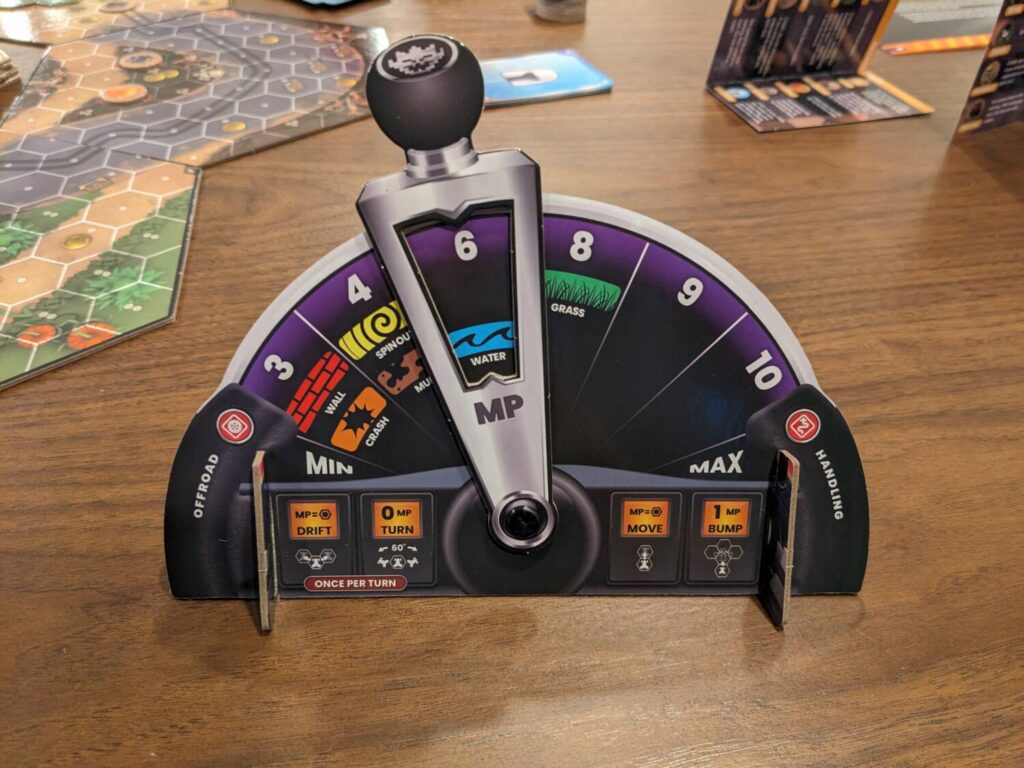
On the positive side, this means that games of Dungeon Kart are always close. I was thankful that my fears that laps might feature a runaway leader were never confirmed. And in each of my plays, I had a turn or two that I was really excited about, thanks to a combination of a card power and a few coins that allowed me to slipstream other karts to take the lead or avoid a hazard before that hazard affected other players.
I really appreciate how well Brotherwise—and in this game’s case, designer Michael Xuereb—gets the themes that nod towards all of us who love a good old-school video game. Sure, the boss monster Killa looks a ton like Donkey Kong, but that just adds to the fun of the world-building. When someone plays a Rage card in Dungeon Kart, it made other players at the table hum the invincibility tune that played any time you grabbed the bouncing yellow star power in Super Mario Bros. Wrecking other karts by bumping them off the tile tracks or into a wall was always funny, and anyone who wrecked was always right back into the race on their next turn with almost no penalty to the affair.
All the older players who joined me for Dungeon Kart lamented the artwork—the images just look a little too animated, if that makes sense. (One person compared it to the artwork in the religiously-themed Veggie Tales books, while the artwork reminded me of one of the dinosaur-themed book series my kids used to read a few years ago.)
I absolutely love the pixelated art style from Boss Monster and Overboss, so it’s really strange that a game in “the world of Boss Monster” (in the words of the publisher) doesn’t use the artwork from that same world. My son went the other way—he loved the art style used on the cover and on the cards of Dungeon Kart. But for something that wants to be thought of in the realm of old-school, 1980s video games—even though the Mario Kart games are a more recent addition to the Nintendo archives—Dungeon Kart doesn’t look quite right.
One other production issue to note: the tile track pieces should have been produced with a jigsaw fit, so that track tiles could lock. As it is, expect a lot of “fiddle” as tiles get jostled during play, or misaligned because a table bump knocks tiles out of place. On my slick kitchen table, tiles would occasionally glide out of place, and players were constantly making adjustments to ensure the tiles collectively resembled a track.
Now, it might ruin the look a bit for certain players, but we started taking tiles out of the track when all players moved past them, since the race is only a single lap. That made it easier to manage the entire course on my table.

Stick with the Short Tracks
Each group that I’ve tried to show Dungeon Kart came away with the same opinion—they didn’t want to play it a second time.
I don’t think that was because of the turn-to-turn gameplay, though. Individual turns are usually fast, and players only have one goal—finish farther ahead of anyone else who crosses the finish line on the final turn. In this way, the mission is always clear.
But Dungeon Kart takes way, way too long to play. Here’s an example of its biggest problem.
In one of the early rounds of my five-player game, all players were able to get a spell token during their turn. That meant that each player took a normal turn, using 6-8 action points to move, turn, etc. One player was able to pick up his second coin, so he spent those to get a two action point boost to his turn. Each player went in turn order, then we did the normal end-of-round cleanup: we reset the current race standings, then all players got to draw a new spell card. The first player token passed to the left, then before the next round began, someone played a Freeze card, which meant that for the upcoming round, all players ahead of that player (the other four players) immediately crashed, which means they reset their speed to the minimum setting of three action points before the next round began.
If any drivers happened to be behind the person who played that card, those drivers could not adjust their speed forward during the upcoming round.
Wild, right? As a one-time action, I loved Freeze because I thought the power was a fun way to reset the standings. But that also meant that all players were suddenly back in first gear, and that happened a bunch during the five-player game. All those preceding steps took 7-8 minutes, to complete a single round of a short racing game. It just felt like we were driving tanks instead of race cars, which only made me want to play a quick game of Mario Kart on my Nintendo Switch Lite instead.

The best way to mitigate the slow pace of Dungeon Kart is to limit both player count and track size. Instead of using the somewhat long-ish beginner track, build a track using the game’s setup rules with fewer tiles. (I am frightened by some of the longer tracks suggested in the secondary rulebook…the “Arcadia 500” looks like a track I would want to try in a three-minute video game format, but not a two-hour board game format.)
Then you have to ask the bigger question: how few racers do you want to play with, knowing that it’s always more fun in a video game to have more competitors on the track?
That five-player game? We were actually set up to play with six, but one player bailed. My son was also supposed to join that game, but he didn’t want to play Dungeon Kart a second time. Now that I look back on that experience, I am so thankful I did not play Dungeon Kart with seven players…I think that would have easily eclipsed two hours of playtime.
I think four players might be the sweet spot with a shorter track, especially if they’ve played the game before. Turns would go faster, there are fewer people taking turns, and you still get chances to bump your opponents into hazards and hose them for a turn or two. I think you could consistently get games done in under an hour, and you might even get a group willing to play a second time back-to-back on a different track.
By the time I drafted this review, I was surprised how badly I wanted to play Thunder Road: Vendetta instead of Dungeon Kart . Both games are a race to the finish line, but the car combat is a lot more interesting without much additional weight to the rules overhead. And as I noted in my review last year, TR:V’s biggest problem is also its length. But somehow, five-player games of TR:V are shorter than five-player games of Dungeon Kart, with a similar squeeze.
Dungeon Kart was OK. As an ode to one of the greatest video game series ever made, Dungeon Kart nails most of the nostalgia elements. I just wish it was a lot shorter.


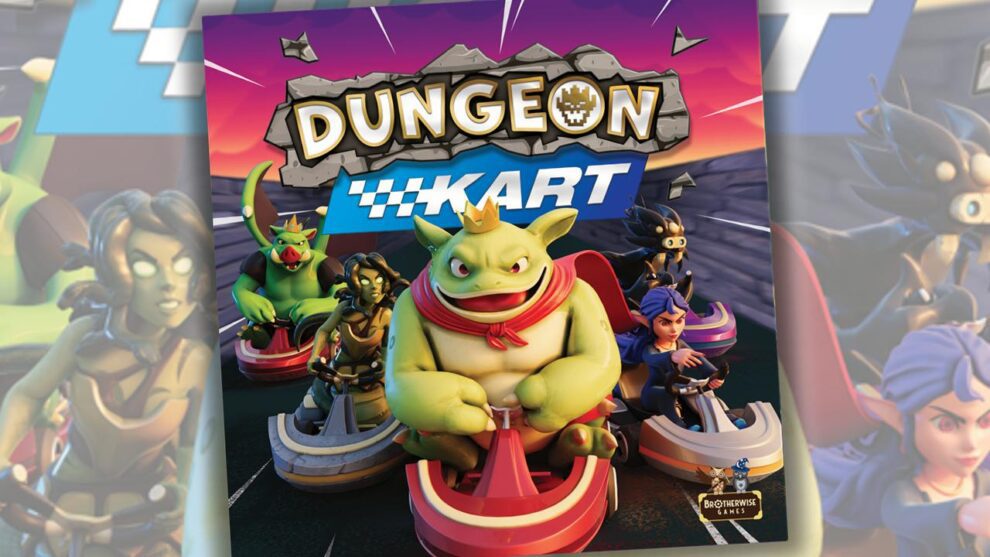
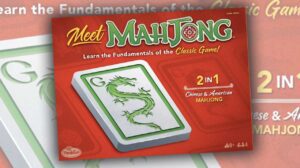
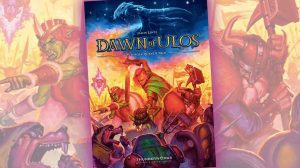

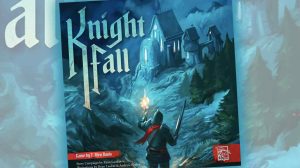




Add Comment